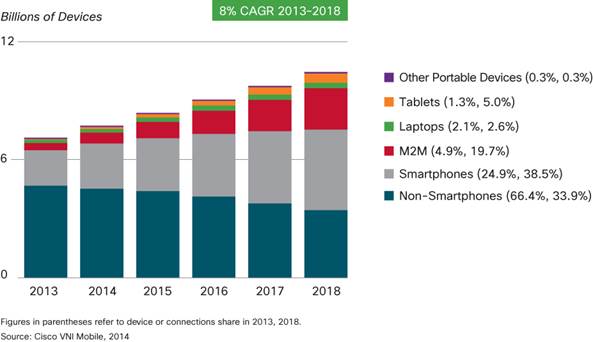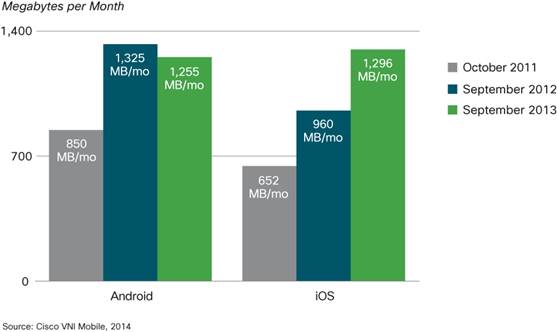Mobile Devices Triumph in Web
Every year new types of smart mobile devices appear generating an increasing mobile traffic growth. Just from 2012 to 2013 over 500 million new connections were added, making 7 billion in total, with an estimation of 10.2 billion connections in 2018. The number of mobile devices and connections will increase the fastest in North America and Western Europe.


Until recently data consumption on Android devices was at the same level as other smartphone platform or ever higher. At the moment, the lead belongs to Apple devices in terms of megabytes per month per connection usage, but the difference is rather small. All smartphone users have increased their data consumption in the last couple of years, regardless of the type of their data plan and both platform devices are prominent bandwidth promoters in tiered as well as unlimited plans.
According to Adobe Digital Index, after analyzing more than 100 billion visits to 1000+ websites worldwide in 2012 and 2013, global websites are now getting about more traffic from tablets than smartphones. This result is very impressive for a device that was introduced only several years ago. Visitors using tablets spend more per online order than their counterparts on smartphones, and even more than desktop/laptop users. Not only is tablet traffic more valuable in terms of ecommerce and engagement, tablets have also become the primary device for mobile browsing.

Smartphones remain much more common, but since the comfort that tablet provides, average internet users view 70% more pages per visit when browsing with a tablet compared to a smartphone.
A smartphone optimized site is not the same as a tablet optimized site and marketers should keep in mind that consumers use their various mobile devices differently. Consumers all over the world are trying out their tablets for the first time and it only takes one bad website experience for them to decide to go elsewhere. They want more personalized experiences when they visit the store with their tablet because they aren’t just price comparing, but they’re purchasing. They’ll be disappointed if they’re not able to take full advantage of the smooth touch interface and awesome screen resolution of their new toy.
The data shows that tablet use is increasing, but phones are getting bigger while tablets are getting smaller and latest tablets not only look like large smartphones, they have smartphone capabilities — the ability to make phone calls. So marketers can’t rely on screen size anymore to determine and deliver the most appropriate experience but they need to pay attention to connection type (wifi vs. cellular), and referral source along with form factor to prioritize which options to offer the user.
Sources
HARNESSING THE POWER OF MOBILE APPS FOR THE BENEFIT OF YOUR BUSINESS









